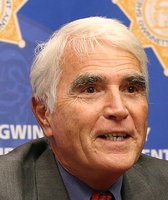Stand up for the facts!
Our only agenda is to publish the truth so you can be an informed participant in democracy.
We need your help.
I would like to contribute
Ad about Deal and scholarship Mostly True
Former Democratic Gov. Zell Miller has had at least a small role in this year’s two biggest elections: the race for U.S. senator and governor.
First, Miller endorsed Democrat Michelle Nunn over Republican businessman David Perdue for Georgia’s open U.S. Senate seat.
Then he came out for Republican Gov. Nathan Deal in his close race against state Sen. Jason Carter.
In campaign ads currently airing in the Atlanta television market, Miller gives Deal credit for saving Georgia’s lottery-funded HOPE scholarship, arguably the most popular state program ever created.
"HOPE was a big achievement for Georgia," Miller says in the ad. "But when it ran into trouble and headed for bankruptcy, Nathan Deal rose to the challenge. Now, thanks to Nathan, HOPE is available for the next generation."
Those are strong words from Miller, considered the founder of HOPE. PolitiFact decided to take a closer look.
First, a little background on the merit-based scholarship program that inspired a federal tax credit and persuaded more than a dozen states to start their own lotteries and scholarship programs.
In 1991, newly elected Gov. Zell Miller proposed legislation calling for a constitutional amendment to create a state lottery. Voters approved the amendment a year later, funding three distinct programs: the HOPE scholarship; universal voluntary pre-kindergarten for 4-year-olds; and instructional technology. That third program was later abandoned.
The first HOPE scholarship was awarded in 1993, and by 2010, more than $5.2 billion in scholarships and grants had been awarded to more than 2.9 million students attending Georgia colleges, universities and technical colleges.
The popular program was simple: earn and keep a 3.0 grade-point average and receive free tuition to a public college.
But Deal and lawmakers were presented with a dire forecast heading into the 2011 General Assembly session, Deal’s first as governor.
If changes weren’t made to HOPE and pre-k by the fiscal year that started July 2012, all the lottery’s reserves would be depleted. Some of the needs of pre-k and HOPE also would not be met, lawmakers were told.
Deal led the revamp effort. He included some Democratic ideas in the final bill. For instance, House Minority Leader Stacey Abrams pushed for, and won, retaining $13 million in the program to cover technical college students taking remedial classes.
Her negotiations with Deal also kept grants for 5,000 students to continue at proprietary schools such as DeVry – and met some pushback from Democrats angry at her cooperation.
But Abrams gave a rare impassioned speech during the House floor vote, noting the program remained a way to invest in Georgia students and included both political parties’ priorities. She stood next to Deal as he signed what would be the signature legislation of his first year as governor.
Featured Fact-check
The biggest change to emerge: students with a 3.0 grade-point average would no longer receive a full college scholarship. Those would be reserved for about 10 percent of students -- valedictorians, salutatorians and those with at least a 3.7 GPA and a combined 1200 on the math and reading sections of the SAT.
These students, now known as Zell Miller scholars, also would be required to maintain a 3.3 GPA in college to keep the full scholarship. Other major changes eliminated the automatic increases in scholarship awards to match tuition increases and raised the GPA for technical school grants from 2.0 to 3.0.
Renewed criticism of the changes came the following year, when almost 9,000 students lost the technical school grants because they couldn’t meet the higher academic standards.
Thousands more did not enroll because they couldn’t afford to pay what HOPE no longer covered, according to the commissioner of the state’s technical college system. By 2013, lawmakers reverted to the 2.0 GPA for technical college students, who tend to be older and work full time while attending school.
Carter, this year’s Democratic nominee for governor, was among those who didn’t agree with the changes that were made. Carter and Senate Democrats favored a $140,000 family income cap, a proposal GOP leaders dismissed as fiscally impractical.
Carter has maintained his criticism of Deal on HOPE during this year’s campaign, saying the governor’s to blame for tens of thousands of students no longer receiving HOPE.
Earlier this year, the left-leaning Georgia Budget and Policy Institute issued a report showing that the post-2011 scholarship program, which some have dubbed "HOPE Lite," continues to pay less and less of the costs of attending college.
At Georgia Tech, for example, a HOPE scholarship that once covered all tuition and mandatory fees, plus a book allowance, now covers 59 percent of tuition costs. At the University of Georgia, a scholarship pays 62 percent of tuition costs, the researchers found.
The number of HOPE recipients dropped from about 250,000 in 2010-2011 to about 200,000 in 2013-2014, and scholarship and grant awards in that period were down about $215 million, from $747.6 million to $532.9 million, according to the Georgia Student Finance Commission’s website.
We tried to get Miller’s take on those major changes but could not reach him. But when our colleague at The Atlanta Journal-Constitution, Janel Davis, spoke with him a week ago, he said Deal was true to his goal for HOPE.
"He held to that original thinking of mine that it was for the best students, not the best students who might have low-income families, but just the best students period," Miller said. "I still think it serves a wonderful purpose, and that’s to give students an incentive to do well."
Our ruling
With bipartisan backing from the General Assembly, Deal made changes that eased financial pressures on the popular HOPE scholarship. But the program also changed significantly.
The program is still making higher education more affordable for many students. But now, only about 10 percent of HOPE recipients receive scholarships that cover 100 percent of their tuition costs.
You could make the argument that Miller makes here: Deal -- with a little help -- saved the HOPE scholarship.
But Miller’s declaration needs a bit of context to be fully understood.
We rate his statement Mostly True.
Our Sources
The Atlanta Journal-Constitution, "Abrams ensures Dems get heard," March 27, 2011
The Atlanta Journal-Constitution, "Deal proposes HOPE changes for technical colleges," Feb. 7, 2013,
HOPE Scholars Pick Up Increasing Share of College Costs,Georgia Budget & Policy Institute
Georgia Student Finance Commission, HOPE data,
ENDURING HOPE: Deal legislation saves nation's most generous benefits for future generations, Governor's Office, Feb. 22, 2011
HOPE program changes, GAcollege411
:HOPE on a Tightrope," Georgia Budget & Policy Institute, February 2012
Browse the Truth-O-Meter
More by Nancy Badertscher
Ad about Deal and scholarship Mostly True
Support independent fact-checking.
Become a member!
In a world of wild talk and fake news, help us stand up for the facts.





























































